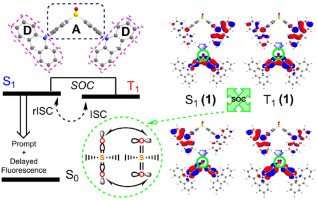Organic Electronics ( IF 2.7 ) Pub Date : 2020-03-29 , DOI: 10.1016/j.orgel.2020.105733 Dalius Gudeika , Jiun Haw Lee , Pei-Hsi Lee , Chia-Hsun Chen , Tien-Lung Chiu , Glib V. Baryshnikov , Boris F. Minaev , Hans Ågren , Dmytro Volyniuk , Oleksandr Bezvikonnyi , Juozas V. Grazulevicius

|
Flexible versus rigid molecular structures of donor-acceptor-donor type compounds are investigated with respect to efficiency of thermally activated delayed fluorescence (TADF) by theoretical and experimental approaches. Three highly efficient TADF emitters based on flexible diphenylsulfone and rigid dibenzothiophene dioxide as acceptor units and di-tert-butyldimethyldihydroacridine as donor moiety were designed and synthesized. Despite they showed similar singlet-triplet splitting (0.01–0.02 eV) and high photoluminescence quantum yields in appropriate hosts, maximum external quantum efficiencies as different as 24.1 and 15.9/19.4% were obtained for organic light emitting devices based on these emitters with, respectively, flexible and rigid molecular structures. The high efficiency of the light-emitting compounds with the flexible molecular structure could be traced to the bi-configurational nature of the lowest singlet and triplet states resulting in higher spin-orbit coupling than for molecules with rigid structures. All derivatives showed bipolar charge transport character. High device efficiency with electron mobility of 3 × 10−5 cm2V−1s−1 and hole mobility of 1.3 × 10−4 cm2V−1s−1 at the electric field of 5 × 105 Vcm−1 was recorded for the layer of para-disubstituted diphenylsulfone with flexible molecular structure. This TADF emitter showed an excellent performance in the organic light emitting device, exhibiting a maximum current efficiency, power efficiency, and external quantum efficiency of 61.1 cdA-1, 64.0 lmW−1, and 24.1%, respectively.
中文翻译:

柔性二苯砜与刚性二苯并噻吩二氧化物作为供体-受体-供体TADF发射体中的受体部分,用于高效OLED
通过理论和实验方法研究了供体-受体-供体型化合物的柔性分子结构与刚性分子结构的热活化延迟荧光(TADF)效率。基于挠性二苯砜和刚性二苯并噻吩二氧化物作为受体单元和二酯的三种高效TADF发射器设计合成了丁基丁基二甲基二氢ac啶。尽管它们在适当的宿主中显示出相似的单重态-三重态分裂(0.01–0.02 eV)和高的光致发光量子产率,但基于这些发射器的有机发光器件分别获得的最大外部量子效率分别为24.1%和15.9 / 19.4%, ,灵活而刚性的分子结构。具有柔性分子结构的发光化合物的高效率可以追溯到最低单线态和三线态的双构型性质,从而导致自旋轨道耦合性高于具有刚性结构的分子。所有衍生物均表现出双极电荷传输特性。器件效率高,电子迁移率达3×10 -5 cm 2对于具有柔性分子结构的对二取代二苯砜层,记录了在 -5×10 5 Vcm -1的电场下的V -1 s -1和空穴迁移率1.3×10 -4 cm 2 V -1 s -1。此TADF发射显示在有机发光器件的优异的性能,表现出最大电流效率,功率效率,和61.1 CDA的外部量子效率-1,64.0 LMW -1,和24.1%之间。











































 京公网安备 11010802027423号
京公网安备 11010802027423号